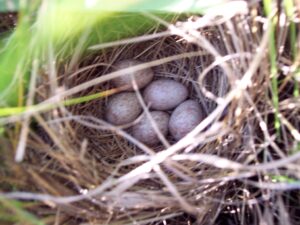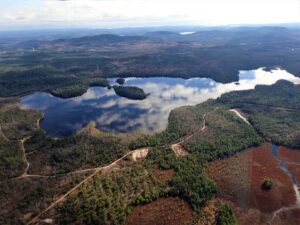Several new or ongoing grants were secured to assist ACJV partner efforts to conserve land, implement restoration projects, and test promising management actions outlined in our conservation plans. For the third year in a row, every NAWCA and National Coastal Wetland Conservation Grant proposal submitted by ACJV partners was funded! Read more about all of our funding success stories below.

Saltmarsh restoration projects benefit many species including Whimbrel. Alan Schmierer
National Fish and Wildlife Foundation (NFWF) Funding
New climate resiliency funding provided through the Bipartisan Infrastructure Law to NFWF allowed several new priority salt marsh restoration projects to proceed. Several projects were funded in Maine and Massachusetts and two projects that are focused on beneficial use of dredged sediments were funded in the South Atlantic. Of particular note, the Great Marsh system in Massachusetts received two grants that will collectively address designs and implementation of critical tidal marsh restoration across nearly 5,000 acres of marsh. In addition, these two grants are complemented by other grants to partners in the watershed. These include a NOAA grant that will address five dams in the Parker River watershed and a State Hazard and Climate Adaptation Plan grant that is supporting development of designs for an additional 3,000 acres of salt marsh by this summer for a grand total of more than 8,000 acres of marsh conserved or under active restoration! The benefits of this work extend well beyond the Saltmarsh Sparrow to include the full suite of tidal marsh birds, fish habitat, carbon capture and community protection. A huge congratulations to the Trustees, MassWildlife, Mass Audubon, Ipswich River Watershed Association, Ducks Unlimited, the USFWS, and the many partners working in this region!

Saltmarsh Sparrow nest. Rhonda Smith/USFWS
Natural Resource Conservation Services (NRCS) Conservation Effects Assessment Project (CEAP)
The JV was awarded a third year of funding from NRCS through the CEAP program. To date, this grant has supported the following accomplishments, all implemented by partners:
- The leading cause of decline in Saltmarsh Sparrows is low reproductive success, however this metric is difficult and expensive to monitor. Partners at SHARP developed and tested protocols to quickly assess demographic rates for saltmarsh sparrows and other tidal marsh obligate birds across multiple sites. Analyses indicate a relationship between the rapid and the intensive protocols for Saltmarsh Sparrow that will facilitate more efficient evaluation of demographic metrics in the future. The results of these analyses are final pending further updates during peer review.
- The University of NH is evaluating runnel (shallow channels dug to remove standing water from the marsh) performance across 19 partner projects in RI, MA and ME, with additional sites to be added annually to understand how marshes respond to this restoration technique along different parts of the coastline. Preliminary results show that treatment areas are being colonized by high-marsh grass species; before runnelling, these sites had only supported monocultures of low marsh grass.
- The Center for Conservation Biology (CCB), in collaboration with the ACJV Black Rail Working Group, released a Black Rail Management Guidance document in January 2023. This document includes a set of habitat endpoints, management techniques for achieving them, identification of management units, and objectives for each unit.
- SHARP has begun to evaluate the use of remote sensing to identify habitat characteristics linked to successful breeding of Saltmarsh Sparrows to help prioritize sites with the greatest potential for restoration. This work is being led by the University of Connecticut.
North American Wetlands Conservation Act & National Coastal Wetlands Conservation Grants
For the third year in a row, every proposal from ACJV partners that was submitted to the USFWS’s two national wetland grant programs (i.e., NAWCA and Coastal grants) in 2022 was funded, repeating last year’s 100% success rate. In the two rounds of NAWCA Standard ($1M +) grants submitted, twelve proposals were funded, providing $16.5 M to conserve 38,776 acres. NAWCA grants were awarded in Maine, Virginia, North Carolina, South Carolina, Georgia, and Florida this year. Nearly half of the awards were in the $1.5M – $2M range. NAWCA Small ($100k) grants submitted in 2022 will be evaluated and awarded in the spring of 2023.
All six proposals for Coastal grants submitted from ACJV states in 2022 were funded. Nearly $5M in grants (and nearly $7M in match) will conserve 11,832 acres in North and South Carolina, and Maine.

Aerial view of Narraguagus Lake and tributary wetlands.. Mark Berry
NAWCA Project Highlight: Maine
Partners in Maine have been regular, repeat recipients of NAWCA funds since the beginning of the program. The state’s rich network of small/local and large, state-wide land trusts, and the strong collaborative spirit among Maine partners–including the Department of Inland Fisheries and Wildlife–have always aligned well to the goals of this national grant program. Maine partners have generated significant conservation activity in recent years, in part by taking advantage of a very large donation of land through NAWCA matching requirements which allow applicants to bank “excess match” (that exceeds the typical $2M match threshold). Elliotsville Plantation Inc (EPI), a family foundation started by the co-founder of Burt’s Bees, had been working for many years to protect land in Maine in hopes of establishing a new national park. In 2016, EPI gifted 87,500 acres (and a $20M endowment) to the American people, which President Obama designated as Katahdin Woods and Waters National Monument, managed by the National Park Service.
EPI allowed conservation partners across Maine to leverage nearly half of KWW’s acreage–and its value–as non-federal match for several NAWCA grants. In 2018, Maine Coast Heritage Trust, The Nature Conservancy, and Kennebec Estuary Land Trust–working with many other partners–submitted three successful proposals that collectively banked ~$29M in match that would be available for future proposals over the next five years. Partners have since submitted ten more proposals that were funded. Partners have now collectively been awarded $16.5M in grants (matched by nearly $50M), which will conserve 137,123 acres! Although some of this total includes KWW acreage that was used as match, about 85,000 acres of protected lands have resulted from this effort in under five years–an acreage nearly equal to the total KWW land donation in 2016! Calendar year 2023 is the final year that Maine partners can use this banked match, so we expect to see additional grant awards added to their accomplishments before next year’s annual report.
Great Lakes Restoration Initiative

Largest island of the Robinson Island Group. Thousand Island Land Trust
Under the Great Lakes Restoration Initiative (GLRI), the ACJV and Upper Mississippi and Great Lakes Joint Venture co-administer the Joint Venture Habitat Restoration and Protection grant program. This year, we only received two proposals from the ACJV portion of the Great Lakes, but we were able to fund both projects. Though our grants provided only a portion of the funding partners need to close these projects, we expect both projects to be fully completed (e.g., one of the proposals is also seeking a NAWCA Small Grant). We awarded $60,500 for the DeMink Forest project and $240k for the Habitat Diversity Protection in the St. Lawrence River Valley (Phase 2) project (details below).
DeMink Forest – The Western New York Land Conservancy will permanently protect (in fee) 223 acres that are adjacent to the 168-acre College Lodge Forest property, which was protected by a previous ACJV GLRI grant. The site contains a rare “floating bog” peatland, which is home to many rare orchids and carnivorous plants. Just a few miles from Lake Erie, it will provide valuable stopover habitat for many migrating birds.
Habitat Diversity Protection in the St. Lawrence River Valley (Phase 2) – Thousand Islands Land Trust will permanently protect (in fee) two properties: the Delano Grasslands (290 acres) in Alexandria, and the largest island of the Robinson Island Group (5 acres) in the St. Lawrence River. The former tract is under threat of conversion to row crops or industrial solar energy production, whereas the latter tract is under imminent threat of development. These tracts will provide strong habitat values to high priority bird species such as Eastern Meadowlark and Henslow Sparrow, in the grassland, and support thousands of Long-tailed Ducks, Redheads, and Scaup which convene around the island during winter.
